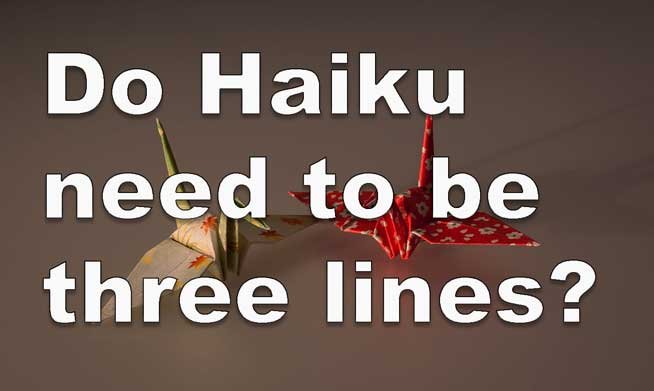
A few days ago I covered how many syllables a haiku should be. Read that here. Today I want to look at how many lines a haiku should be. Three? Five? Forty-two? Curious? Read on!
Haiku in Japan
In Japan, a haiku is usually printed on a single line. The poem naturally divides into three lines when we hear it, and so it is sometimes written that way.
It's worth repeating that. In Japanese you can hear the line breaks. Japanese flows into patterns of five and seven very naturally so one can usually hear the breaks in any case, but there are also often extra words (kireji, "cutting words") that help make a stronger break.
In English, we have nothing similar to either these natural breaks or cutting words, making the line breaks somewhat more important.
Early Translations in English
Early translations in English mimicked the single line approach. Some later translators wrote two line translations: one line came before the cutting word and one line after.
Later, a handful of translators settled around writing the English versions in three lines to mimic the three lines heard in Japanese. The most influential of these was probably R.H. Blyth, an Englishman who taught English in Japan and wrote several books introducing haiku and Zen to the West. It was Blyth who the Beat poets latched onto and who Alan Watts preferred. The combined popularity of the Beats and Watts probably had much to do both with Blyth's fame and with the popularity of writing haiku in three lines.
But there were rebels to this format. One, Peter Beilenson, published his translations as four lines. He didn't intend this to be any kind of a statement on format—in fact, in the introduction of his book he blamed the format on horizontal space limitations due to a narrow book design; whatever the reason may have been, it was an interesting choice. He also wrote the haiku in all caps, something that is less jarring in print than it is on the Internet WHERE WE TAKE IT FOR SCREAMING!
Here is an example of his style (minus the all caps):
Ah! I intended
Never never
to grow old...
Listen: New Year's bell!
(Here's my translation of the same verse)
Modern Haiku in English, Translations, and Original
Today, almost all haiku in Japan continue to be written on a single line. In English, both translations and original haiku tend to use three lines, though you can occasionally find the bold haijin† who doesn't stick to this format.
But does it need to be this way?
In English poetry, line breaks often give us pause. There is a slight hesitation. It makes us break
and consider
what we
just read.
This is exactly why they are used in haiku to mimic the natural break that the Japanese can hear but we can't in English.
So that is to say, a line break can be a useful tool in English poetry, one I think free-verse poets have been taking advantage of for a long time. It's also a tool I propose we take advantage of in haiku as well.
English is not Japanese. That may seem obvious, but yet with haiku we are trying to copy a Japanese structure into English, a structure that doesn't fit our language. I covered this a little in my previous essay so I won't go into it too much. Suffice to say I think we should try to copy the feeling of haiku but not the structure. This means a short verse, as short as possible (aim for one breath), ideally with a reference to nature and some kind of image juxtaposition. But it doesn't mean seventeen syllables or three lines.
How Many Lines Can We Go??
Let's use the example haiku I wrote for my previous essay.
evening
snow beating down
my son is snoring
That's not bad. We have a setting, a feeling (cold), and then cut to an unpleasant but somewhat adorable noise, given who it is coming from. The line break after each line gives us a small pause. The change in images between the second and third line gives a slightly bigger pause.
What if I rewrote it like so:
evening
snow beating down
my son
is snoring
Well now... that changes it a little. Whether it is a good change or not is a matter of opinion, but the change is there. Now, suddenly, we are shifting images to my son and spend a moment admiring him before—pause again—noticing he is making a rather unpleasant sound.
I think using line breaks is a very powerful tool in poetry and we should use it to its full potential in haiku.
Final Word
There are of course sticklers out there who will insist haiku must be exactly seventeen syllables written in three lines of 5/7/5, and so we risk a small argument from this crowd if we publish haiku differently, but I think the potential artistic rewards far outweigh that risk.
If you do run into any of those sticklers, you can refer them to my previous essay on why syllable count in haiku doesn't matter.
What do you think?
Footnotes
†: haiku poet
❦
| If you enjoyed this post, please like and resteem. Also be sure to follow me to see more from Japan everyday. |
|---|
I post one photo everyday, as well as a haiku and as time allows, videos, more Japanese history, and so on. Let me know if there is anything about Japan you would like to know more about or would like to see.
| Who is David? | |
|---|---|
 | David LaSpina is an American photographer lost in Japan, trying to capture the beauty of this country one photo at a time. |
